According to a comprehensive study by Ahrefs, 96.55% of all pages receive zero search traffic from Google, highlighting the significant challenge of achieving visibility in search results. This statistic underscores the importance of understanding and leveraging Google’s ranking factors, as only a small fraction of web pages successfully attract organic search traffic.
On This Page
Here’s my list of 19 stats about ranking on Google. Enjoy!
Impact of Backlinks on Rankings

Backlinks remain a crucial factor in search engine rankings, with studies indicating their significant impact on a website’s visibility and authority. According to a comprehensive analysis by Backlinko, pages with the highest number of total backlinks tend to rank best in Google search results 1.
The study found that the #1 result in Google has an average of 3.8x more backlinks than positions #2-#10 1. Additionally, a survey by Authority Hacker revealed that 67.5% of SEO professionals believe backlinks have a big impact on search engine rankings 2.
The quality of backlinks is also essential, with links from authoritative and relevant sources signaling to search engines that the content is valuable and credible 3. However, it’s important to note that backlinks alone are not sufficient; factors such as content quality, user experience, and expertise also play crucial roles in determining rankings 4.
Sources:
- (1) We Analyzed 11.8 Million Google Search Results. Here’s … – Backlinko
- (2) The State of Backlinks for SEO in 2024 – uSERP
- (3) Backlinks Explained: Impact Rankings, Types and Much More
- (4) Are backlinks becoming a bigger ranking factor than it should be?
Role of Domain Authority

Domain Authority (DA) is a search engine ranking score developed by Moz that predicts how likely a website is to rank in search engine result pages (SERPs) 1. Ranging from 1 to 100, with higher scores indicating greater ranking potential, DA is calculated using multiple factors, including linking root domains and total number of links 1.
While not a direct Google ranking factor, DA serves as a comparative metric for assessing a website’s “ranking strength” over time 1. It’s particularly useful for tracking link building efforts and estimating keyword difficulty 2.
However, it’s important to note that DA should not be used in isolation to determine a website’s quality or ranking potential, as search engines consider numerous other factors in their algorithms 2 3.
Sources:
- (1) Domain Authority: What is it and how is it calculated – Moz
- (2) Why Is Good Domain Authority Important for SEO? – LinkBuilder.io
- (3) What is Domain Authority & Why It Matters – Oyova
Significance of Dwell Time

Dwell time, the duration users spend on a webpage before returning to search results, is an important metric for assessing content quality and user engagement. While not officially confirmed as a direct ranking factor by Google, dwell time provides valuable insights into user behavior and content relevance 1 2.
A longer dwell time generally indicates that users find the content useful and engaging, potentially signaling to search engines that the page offers value 3. Conversely, a short dwell time may suggest that the content does not meet user expectations or answer their queries effectively 3.
To improve dwell time, website owners should focus on creating high-quality, relevant content that addresses user intent, optimize page load speeds, and enhance overall user experience 4. By prioritizing these factors, websites can potentially improve their search engine rankings and overall performance in organic search results.
Sources:
- (1) What Is Dwell Time & Why Does It Matter for SEO – Semrush
- (2) Dwell Time in SEO: All You Need to Know – SpyFu
- (3) What is Dwell Time and How Does it Impact SEO – LinkDoctor
- (4) What Is The Dwell Time: A Comprehensive Guide – seobase
Low Traffic Pages

The vast majority of web pages receive little to no organic search traffic from Google, with only a small fraction attracting a modest number of monthly visitors. According to data from Ahrefs, a mere 1.94% of all pages receive between one and ten monthly search visits from Google 1. This statistic, combined with the fact that 96.55% of pages get zero search traffic, underscores the immense challenge websites face in gaining visibility in search results 1.
These figures highlight the importance of effective SEO strategies and high-quality content creation to stand out in the competitive digital landscape and attract organic search traffic.
Sources:
Featured Snippet Dominance
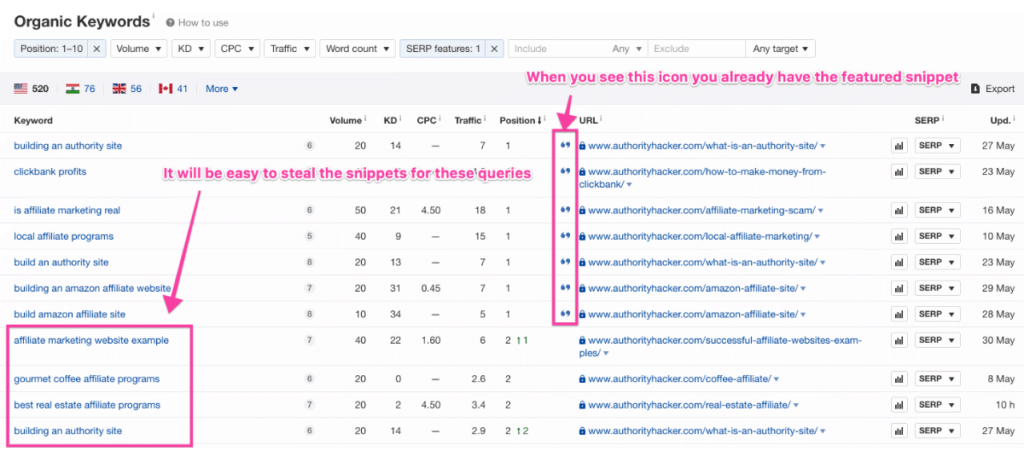
Featured snippets have become a dominant force in search engine results, significantly impacting the visibility and traffic of top-ranking pages. According to a comprehensive study by Authority Hacker, which analyzed over one million search results, 50-65% of all number one spots in Google search results are now occupied by featured snippets 1.
This prevalence underscores the importance of optimizing content for featured snippets, as they can provide an “almost unfair advantage” in search engines 2. Notably, around 60% of featured snippets are owned by sites that don’t hold the first organic position for that keyword, offering an opportunity for lower-ranking pages to leapfrog competitors and gain prominent visibility in search results 2.
This shift in search result dynamics emphasizes the need for SEO strategies that specifically target featured snippet optimization to maximize online visibility and traffic potential.
Sources:
- (1) Featured Snippets – The SEO Pot of Gold Complete Guide
- (2) How to become a master of featured snippets – Search Engine Watch
Top Ranking Traffic Myth
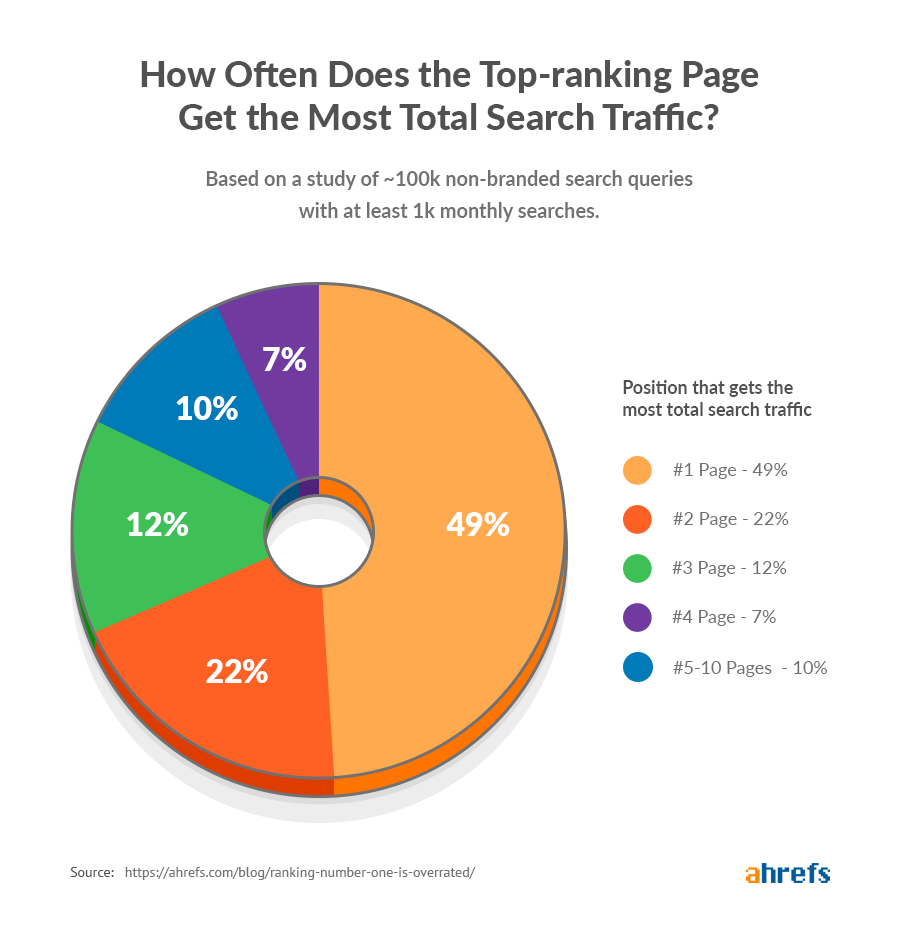
Contrary to common belief, ranking first in Google search results doesn’t guarantee the most organic traffic. According to a comprehensive study by Ahrefs analyzing over 100,000 non-branded search queries with at least 1,000 monthly searches, the top-ranking page receives the most search traffic only 49% of the time. 1
This surprising statistic challenges the traditional SEO focus on achieving the number one position for target keywords. The study reveals that pages ranking lower in search results often outperform the top-ranking page in terms of overall traffic, primarily due to their ability to rank for numerous related long-tail keywords.
This insight suggests that SEO strategies should prioritize creating comprehensive content that addresses a broader range of related topics rather than solely targeting individual high-volume keywords. 2
Sources:
- (1) 124 SEO Statistics for 2024 – Ahrefs
- (2) Ranking #1 on Google Is Overrated (Ahrefs’ Study of 100k Keywords)
Link Impact Timeline

Link building is a crucial aspect of SEO, but its effects are not immediate. According to a survey conducted by Authority Hacker, it takes an average of 3.1 months to observe the impact of links on search rankings 1. This timeframe aligns with the experiences of most link builders, as 89.2% reported seeing results within 1 to 6 months 1.
The delay in impact can be attributed to various factors, including Google’s crawling and indexing processes, as well as the time required for the algorithm to assess and incorporate new link signals.
This statistic underscores the importance of patience and consistency in link building strategies, emphasizing that SEO is a long-term investment rather than a quick fix for improving search rankings 2.
Sources:
- (1) 71 Link Building Statistics Improve Your 2024 SEO Strategy
- (2) Survey Of 755 Link Builders Shows What Works In 2024
Slow Rise to Top

Achieving top search rankings is a challenging and time-consuming process for most web pages. According to a study by Ahrefs, only 5.7% of pages manage to rank in the top 10 search results within a year of publication 1. This statistic highlights the competitive nature of search engine optimization and the patience required for SEO success.
Several factors contribute to this low percentage, including the vast number of existing pages competing for rankings, the complexity of Google’s algorithms, and the time it takes for search engines to crawl, index, and evaluate new content.
To improve ranking chances, website owners should focus on creating high-quality, relevant content, building authoritative backlinks, and optimizing for user experience, while understanding that SEO is a long-term strategy that often requires sustained effort over time.
Sources:
Nofollow Links Impact Rankings
The perception of nofollow links’ impact on search rankings has shifted significantly among SEO professionals. According to a survey by Authority Hacker, 89.1% of link builders believe that nofollow links have an influence on search rankings 1.
This widespread belief challenges the traditional notion that nofollow links provide no SEO value. The high percentage suggests that many SEO practitioners are adapting their strategies to include nofollow links in their link building efforts.
This shift in perspective aligns with Google’s evolving approach to the nofollow attribute, as they announced in 2019 that nofollow links would be treated as “hints” rather than directives for crawling and indexing purposes 1. Consequently, SEO professionals are increasingly recognizing the potential indirect benefits of nofollow links, such as increased referral traffic and brand visibility, which may indirectly contribute to improved search performance.
Sources:
Age of Top Pages

The age of a webpage plays a significant role in its ranking on Google’s search results. According to a comprehensive study by Ahrefs, the average page appearing in the top 10 search results is over two years old. 1 This finding underscores the importance of content longevity and consistent performance over time.
Established pages often accumulate more backlinks, user engagement signals, and content updates, which can contribute to their higher rankings. However, it’s crucial to note that page age alone doesn’t guarantee top rankings; factors such as content quality, relevance, and ongoing optimization remain essential.
For new websites, this statistic highlights the need for patience and persistence in SEO efforts, as it may take considerable time to compete with older, more established pages in search results. 2
Sources:
Reading Ease Ranking Myth

The Flesch Reading Ease (FRE) score, a widely used metric for assessing text readability, has been found to have no significant correlation with Google search ranking positions. According to a comprehensive study by Ahrefs analyzing 15,000 keywords, there was virtually zero correlation between FRE scores and rankings 1.
This finding challenges the common belief that optimizing content for readability directly impacts search engine performance.
While readability remains important for user experience and engagement, the study suggests that Google’s algorithms likely use more sophisticated methods to evaluate content quality beyond basic readability scores 1 2. SEO professionals should focus on creating high-quality, relevant content that addresses user intent rather than solely optimizing for readability metrics like FRE 2.
Sources:
- (1) Flesch Reading Ease: Does It Matter for SEO? (Data Study) – Ahrefs
- (2) Flesch Reading Ease: What a Readability Test Means for SEO
Missing Title Tag Rarity
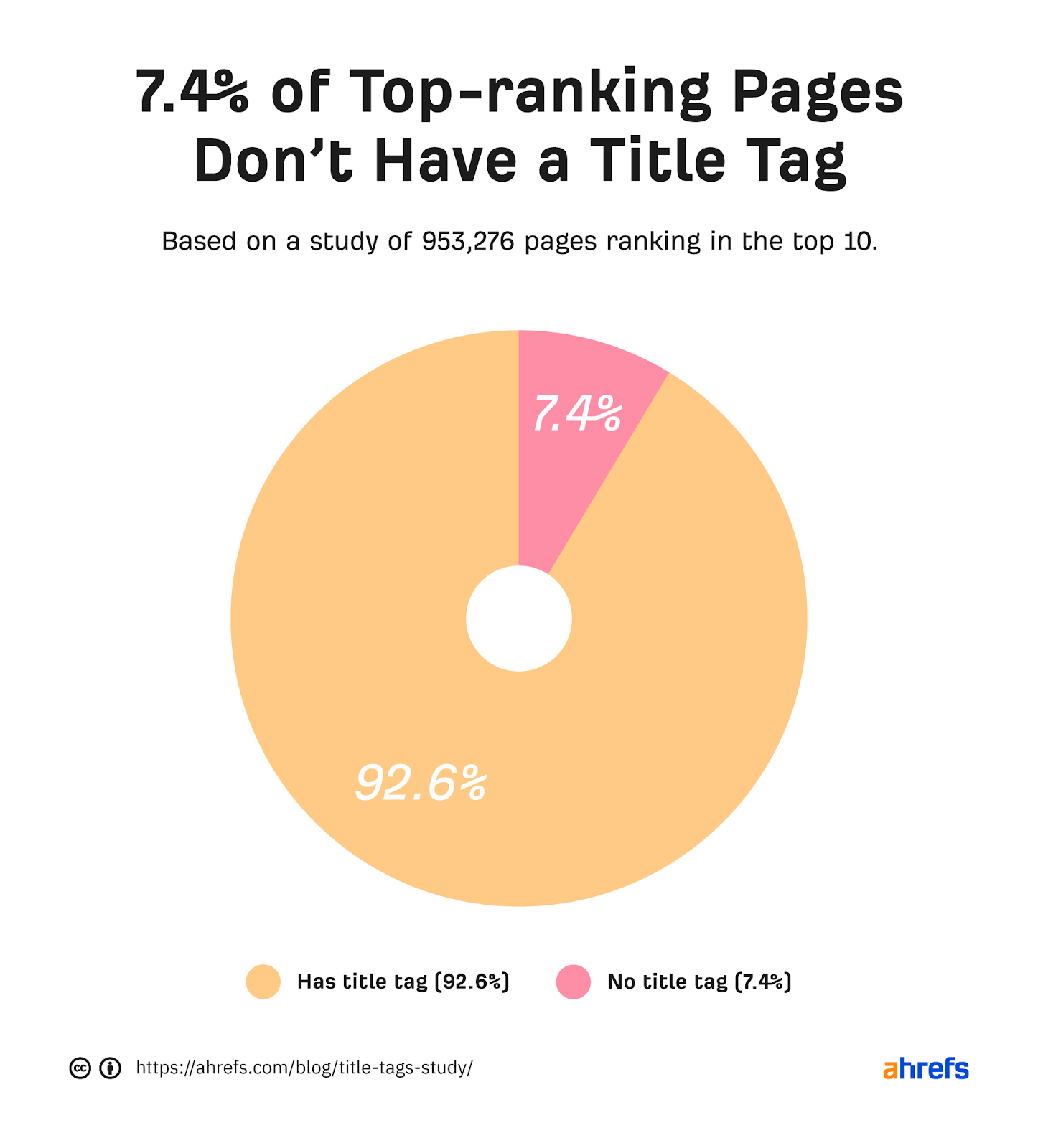
While title tags are generally considered important for SEO, a study by Ahrefs found that 7.4% of top-ranking pages don’t have a title tag 1. This surprising statistic suggests that while title tags are valuable, they are not absolutely critical for ranking well. However, the vast majority (92.6%) of top-ranking pages do utilize title tags, indicating their continued importance.
Title tags serve as a key signal to both search engines and users about a page’s content, appearing in search results and browser tabs 2. For optimal results, SEO best practices recommend including title tags of 50-60 characters with the main keyword near the beginning 1 3.
While pages can technically rank without a title tag, having one increases the chances of ranking well and provides valuable context for search engines and users alike 4 3.
Sources:
- (1) How to Create Search Engine Friendly Title Tags – Neil Patel
- (2) Find all pages without a title
- (3) 6 SEO Page Title Best Practices (+ Examples) – Loganix
- (4) Google: Title Tags Are Not A Critical Ranking Signal
Keyword Ranking Multiplier Effect
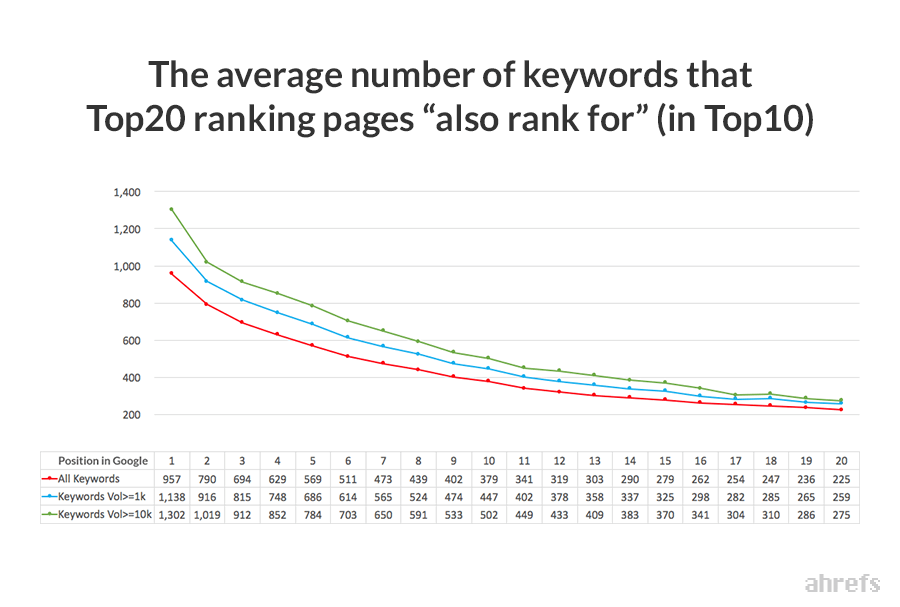
A study by Ahrefs reveals that the average page ranking #1 in Google also ranks in the top 10 search results for nearly 1,000 other relevant keywords. This finding highlights the potential for a single well-optimized page to attract significant organic traffic from multiple search queries. The study showed that lower-ranking pages tend to rank for fewer keywords, with a correlation between higher rankings and more keyword rankings.
For high-volume keywords (over 1,000 searches per month), ranking for 2-3 related keywords is common, while ranking for multiple keywords with over 10,000 monthly searches is rare. This data underscores the importance of creating comprehensive, high-quality content that naturally incorporates related terms and concepts, rather than focusing solely on individual target keywords 1 2.
Sources:
- (1) Study: Top-ranking page in Google ranks for a thousand other …
- (2) How many keywords can you rank for with one page? (Ahrefs’ study …
Title Tag Rewrite Frequency

Google’s practice of rewriting title tags is more prevalent than many website owners might realize. According to a study by Ahrefs, Google rewrites title tags for 33.4% of search results 1. This means that for about one-third of web pages, the title displayed in search results differs from the original title tag specified by the website.
Google implements these rewrites to improve the relevance and clarity of search results for users. Factors that may trigger a title rewrite include titles that are too long, keyword-stuffed, or not accurately representing the page content 2. To minimize the chances of Google rewriting your title tags, it’s crucial to create concise, descriptive titles that accurately reflect the page content and include relevant keywords without overoptimization 3.
Sources:
- (1) How Often Google Rewrites Our Title Tags – Portent
- (2) How To Prevent Google From Rewriting Your Title Tags – GlowMetrics
- (3) 7 Patterns of Google Title Rewriting and How To Deal With It
Meta Description Display Rates

Google’s selective use of meta descriptions in search results highlights the complex nature of search engine optimization. According to a study by Ahrefs, Google displays the original meta description for only 37.22% of search results overall.
This percentage varies depending on the type of keyword, with fat-head (short, generic) keywords seeing meta descriptions 40.35% of the time, while long-tail keywords have meta descriptions shown just 34.38% of the time. These findings suggest that Google often chooses to generate its own snippet from the page content rather than using the provided meta description. This practice underscores the importance of creating high-quality, relevant content throughout the entire page, as any part of it may be used to represent the page in search results.
While meta descriptions remain valuable for SEO, their inconsistent display emphasizes the need for a holistic approach to on-page optimization 1.
Sources:
Title Tag Rewrite Increase

Google’s tendency to rewrite title tags has increased significantly, with a study by Ahrefs revealing that the search engine is now 33% more likely to modify title tags compared to previous years. This trend underscores the importance of crafting effective, concise, and relevant title tags that accurately represent page content. According to data from Wix.com, Google rewrites 65% of desktop titles and 62% of mobile titles as of January 2022 1.
The rewrite rate is consistent across ranking positions, suggesting that Google’s algorithm focuses on improving title relevance rather than considering a page’s rank 1. To minimize the chances of rewriting, SEO professionals should avoid excessively long titles, keyword stuffing, and irrelevant content in title tags 2.
Instead, they should focus on creating descriptive, user-friendly titles that align with the page’s main theme and include relevant keywords naturally 3.
Sources:
- (1) Why Google Rewrites So Many Title Tags – Wix.com
- (2) How To Prevent Google From Rewriting Your Title Tags – GlowMetrics
- (3) 7 Patterns of Google Title Rewriting and How To Deal With It
Truncated Meta Descriptions
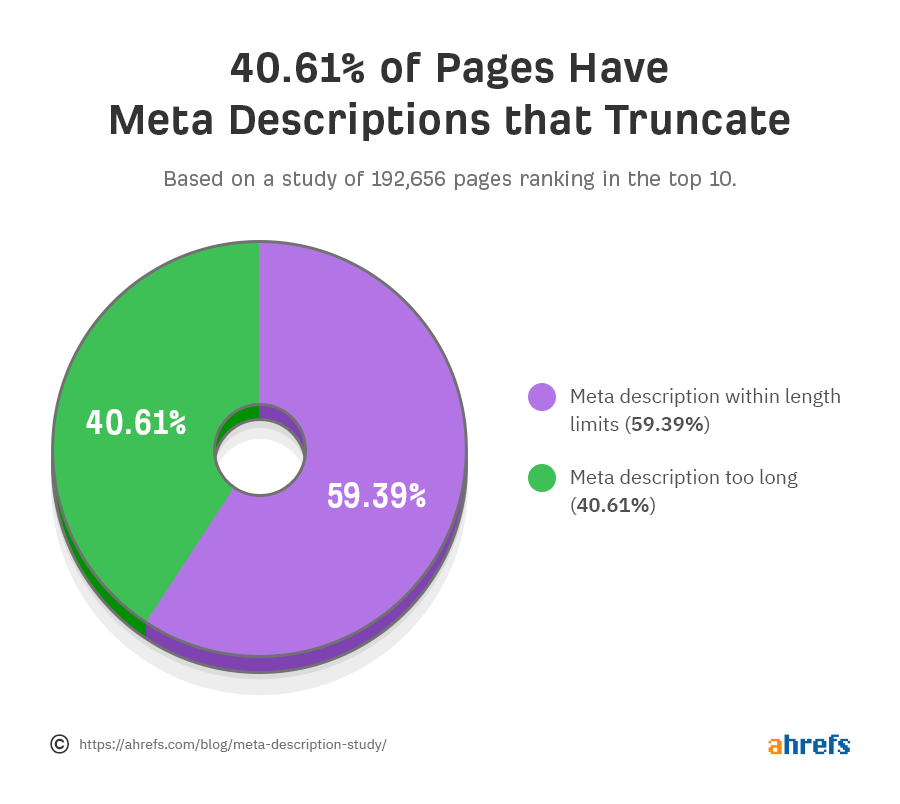
Meta description truncation is a common issue affecting a significant portion of web pages. According to a study by Ahrefs, 40.61% of pages have meta descriptions that truncate in search engine results pages (SERPs). This high percentage indicates that many website owners are not optimizing their meta descriptions effectively for display in search results.
Truncation occurs when meta descriptions exceed the character limit set by search engines, typically around 155-160 characters. When descriptions are cut off, they may fail to convey the full intended message or call-to-action, potentially reducing click-through rates.
To avoid truncation and maximize the impact of meta descriptions, SEO professionals should aim to keep them concise, informative, and within the recommended character limit, ensuring that the most important information appears at the beginning 1.
Sources:
H1 Tag Fallback
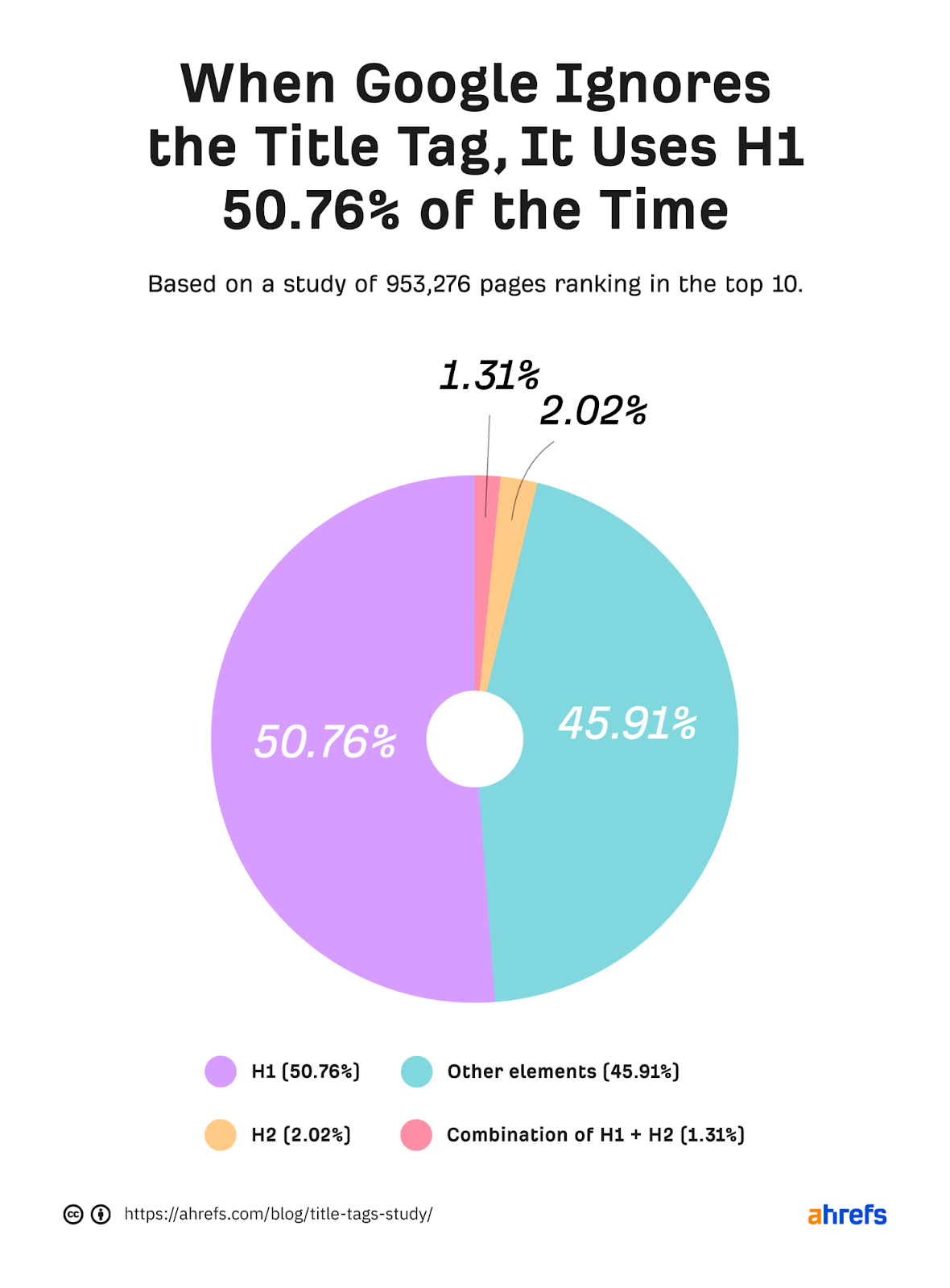
When Google chooses not to use a page’s title tag in search results, it frequently turns to the H1 heading as an alternative. According to a study by Ahrefs, Google uses the H1 tag 50.76% of the time when ignoring the title tag 1.
This underscores the importance of optimizing both title tags and H1 headings for SEO. While title tags remain crucial, with Google using them about 87% of the time overall, the significant use of H1 tags as fallbacks highlights their continued relevance in search engine optimization 1.
To maximize visibility in search results, website owners should ensure that both title tags and H1 headings accurately reflect page content, include relevant keywords, and provide value to users.
Sources:
Meta Description Rewrite Rates
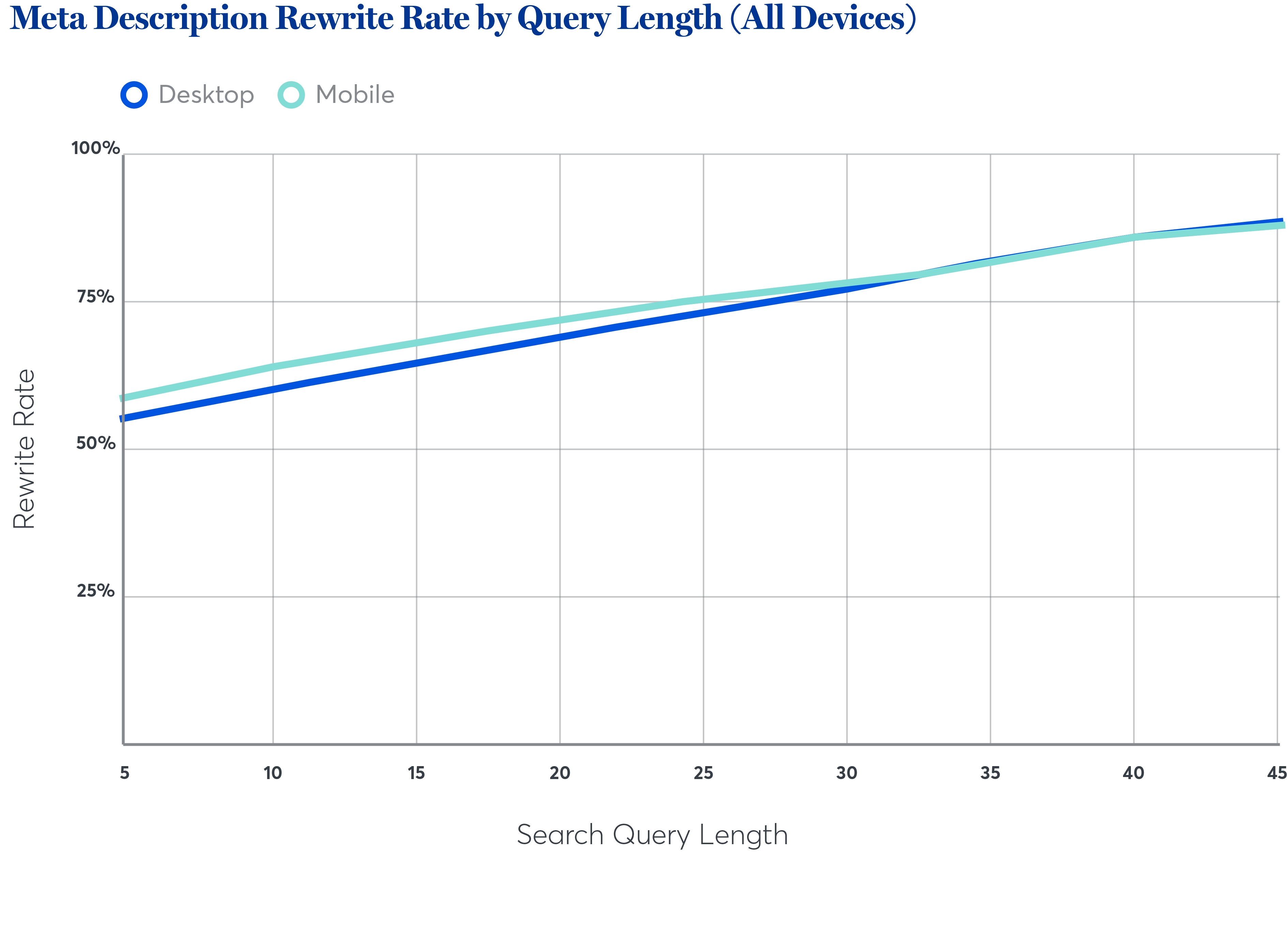
Google frequently rewrites meta descriptions, with a study by Ahrefs revealing that 62.78% of meta descriptions are rewritten in search results. This rewrite rate varies depending on the keyword type, dropping to 59.65% for fat-head (short, generic) keywords and increasing to 65.62% for long-tail keywords 1.
The higher rewrite rate for long-tail keywords suggests that Google aims to provide more relevant snippets for specific queries. Despite this high rewrite rate, meta descriptions remain important for SEO, as they can influence click-through rates when displayed.
To maximize the chances of Google using your meta description, focus on creating concise, relevant, and keyword-rich descriptions that accurately reflect the page content 2 3.
Sources: